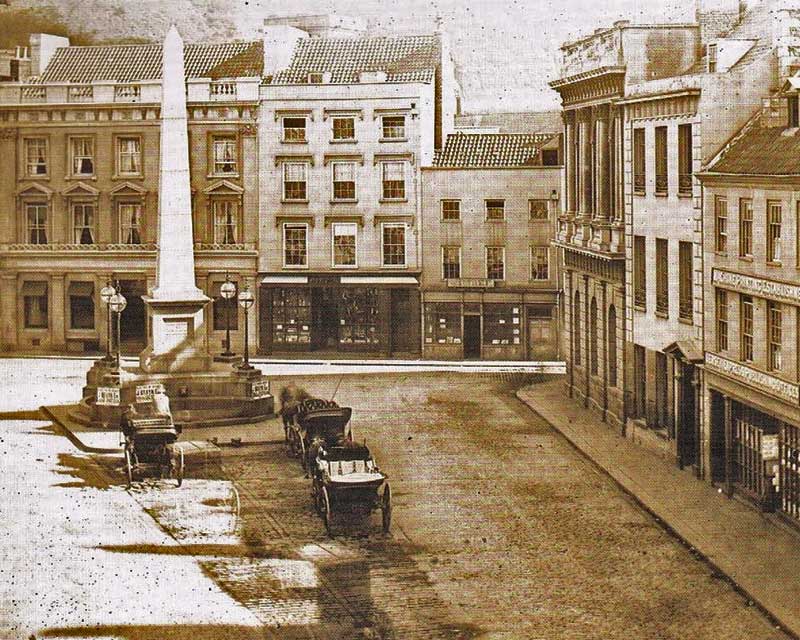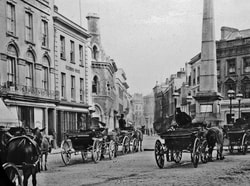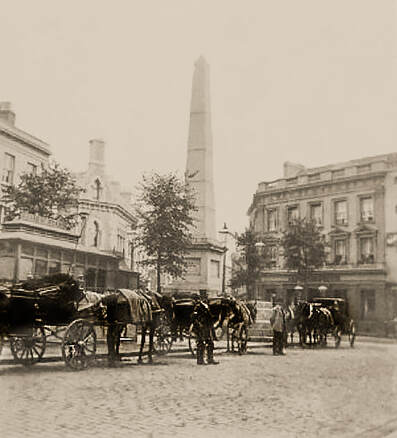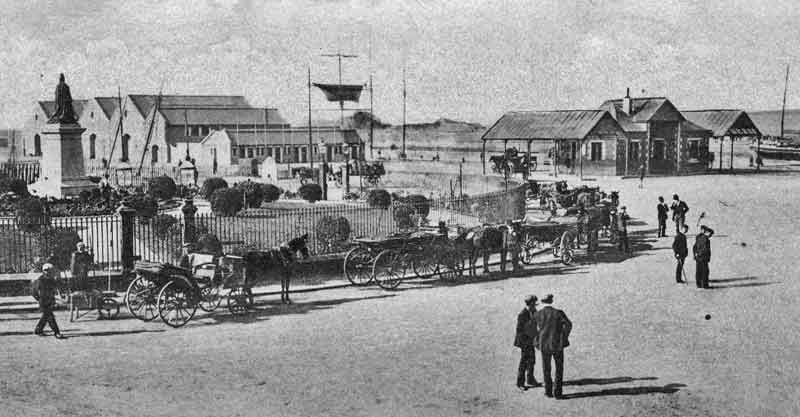Dans les Temps Passés
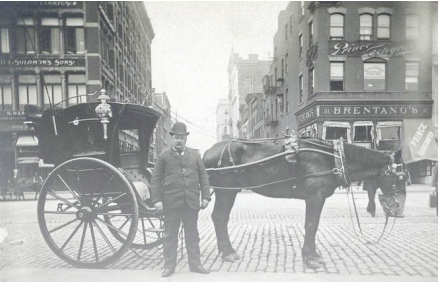
EARLY HISTORY
Its not known exactly when the first individual Cabs applied for hire on Jersey roads, but the first private company to register was in 1850, called the 'Economical Conveyance Company', they had livery stables for 20 horses and premises in Belmont Road for 10 carriages. They tried running on a very economical basis of 4d a mile and they used small one-horse vehicles similar to Paris fiacres. 'A fiacre is similar to the picture opposite and a form of London Hackney coach which was a horse-drawn four wheeled carriage for hire'.
The earliest horse-drawn vehicles used for public hire were known as 'Cabs', Horse-drawn Coaches that carried larger groups were known as 'Charabancs' and usually had bench style seats, but the 'Paris Fiacre' on the other hand was very neat and comfortable.
The attempt to distribute cabs for all parts of St Helier was found to be an economic failure and the rate of charge was insufficient for the experiment to be a success. by 1853 the company sold up and no longer appeared in the registry books.
TAXI TRIVIA
'This is also where the term London hackney carriage comes from today, as used in hackney coaches and cabs which comes from the Norman French word ‘hacquenée’ meaning a type of horse suitable for hire.'
In 1823 a two-seat, two-wheeled carriage called a cabriolet was introduced from France. It was very popular for its speed and comfort and from this vehicle we derive the term ‘Cab’. From the late 1830s, two types of Cab began to dominate the streets of London, the two-wheeled hansom, a fast and elegant carriage and the ponderous four-wheeled ‘growler’ which, with its luggage carrying ability was to be found mostly at harbours and railway stations.
Its not known exactly when the first individual Cabs applied for hire on Jersey roads, but the first private company to register was in 1850, called the 'Economical Conveyance Company', they had livery stables for 20 horses and premises in Belmont Road for 10 carriages. They tried running on a very economical basis of 4d a mile and they used small one-horse vehicles similar to Paris fiacres. 'A fiacre is similar to the picture opposite and a form of London Hackney coach which was a horse-drawn four wheeled carriage for hire'.
The earliest horse-drawn vehicles used for public hire were known as 'Cabs', Horse-drawn Coaches that carried larger groups were known as 'Charabancs' and usually had bench style seats, but the 'Paris Fiacre' on the other hand was very neat and comfortable.
The attempt to distribute cabs for all parts of St Helier was found to be an economic failure and the rate of charge was insufficient for the experiment to be a success. by 1853 the company sold up and no longer appeared in the registry books.
TAXI TRIVIA
'This is also where the term London hackney carriage comes from today, as used in hackney coaches and cabs which comes from the Norman French word ‘hacquenée’ meaning a type of horse suitable for hire.'
In 1823 a two-seat, two-wheeled carriage called a cabriolet was introduced from France. It was very popular for its speed and comfort and from this vehicle we derive the term ‘Cab’. From the late 1830s, two types of Cab began to dominate the streets of London, the two-wheeled hansom, a fast and elegant carriage and the ponderous four-wheeled ‘growler’ which, with its luggage carrying ability was to be found mostly at harbours and railway stations.
PICTURES OF HORSE-DRAWN CABS & CHARABANCS IN JERSEY
|
This is a picture of Broad Street, taken in 1875 and one of the best early pictures of anywhere in Jersey. The photograph was one of a number of surviving pictures of the Street taken by Ernest Baudoux and it shows clearly that the street was surfaced with cobbles and that there were horse-drawn carriages waiting near to the Pierre Le Sueur Memorial which had been completed in 1855. |
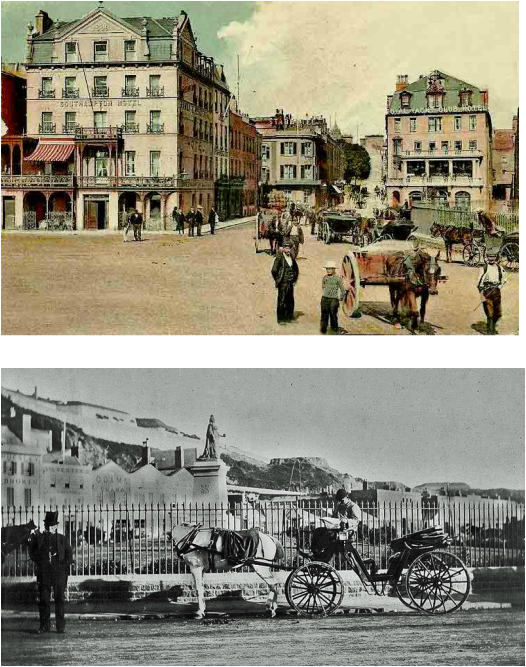 (Date when this photo was taken is not known.)
(Date when this photo was taken is not known.)
To the right we have an early postcard view of the Weighbridge area, some of which were expertly hand-coloured to produce exceptional images of this important part of St Helier the photograph was probably taken in the last decade of the 19th century, or the very early years of the 20th, it shows the Southampton and Royal Yacht Hotels.
The circular garden and statue of Queen Victoria are out-of-shot in this photo and have since been removed, however you can see to the far right of the picture part of the green railings that enclosed the circular garden, and we can see horse-drawn carriages alongside those railings, we know that cabs and charabancs applied for hire next to this garden, and each driver was given his own licenced stand.
The next black and white photo clearly shows the statue of Queen Victoria in the middle of the circular garden. The statue was removed in 1970 and positioned outside the Tourism office near the Weighbridge, this was a temporary location as it was moved again in 1976 to the small triangle park next to the Grand hotel which was renamed Victoria park.
We can see in this picture a cab driver on his stand at the Weighbridge, more or less waiting in the same area where we have the public taxi rank today. At first glance the cab driver looks like he has a headless horse!... the photo was obviously taken when the horse had his head turned, probably having a good old scratch while his driver passes the time of day by reading his news paper while patiently waiting to be hired, 'Not much has changed in that respect for taxi drivers waiting there today!'.
The circular garden and statue of Queen Victoria are out-of-shot in this photo and have since been removed, however you can see to the far right of the picture part of the green railings that enclosed the circular garden, and we can see horse-drawn carriages alongside those railings, we know that cabs and charabancs applied for hire next to this garden, and each driver was given his own licenced stand.
The next black and white photo clearly shows the statue of Queen Victoria in the middle of the circular garden. The statue was removed in 1970 and positioned outside the Tourism office near the Weighbridge, this was a temporary location as it was moved again in 1976 to the small triangle park next to the Grand hotel which was renamed Victoria park.
We can see in this picture a cab driver on his stand at the Weighbridge, more or less waiting in the same area where we have the public taxi rank today. At first glance the cab driver looks like he has a headless horse!... the photo was obviously taken when the horse had his head turned, probably having a good old scratch while his driver passes the time of day by reading his news paper while patiently waiting to be hired, 'Not much has changed in that respect for taxi drivers waiting there today!'.
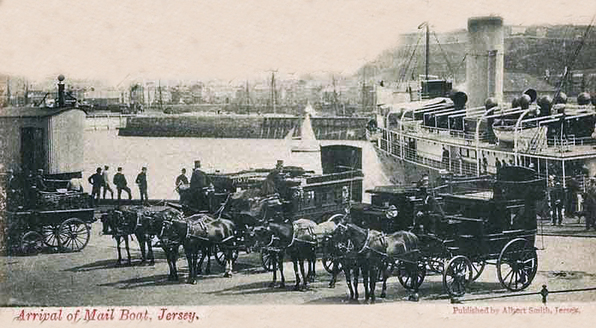
This old post card picture was taken in 1903 by local photographer Albert Smith.
The picture shows horse-drawn carriages waiting for the arrival of the mailboat at St Helier harbours. Some of the island hotels also supplied horse drawn carriages for their guest besides the public cabs and private coach companies.
The picture above taken in 1908 shows a line of horse-drawn cabs for hire where later motorised taxis would queue, until most of this area was given over to the JMT bus company in the 1970s.
It was also in 1908 when cab drivers were officially licensed by the different Parishes and records kept of the driver's name and address, plus they were given a public service badge number... All the carriages were documented as cabs, with each driver assigned a plate number for their horse-drawn carriage, ranging from 1 to 81. This plate number served as both the driver's badge and stand number. The license granted permission to apply for hire for passengers at the harbours and public stands, equivalent to today's public taxi ranks. St. Helier's historical records reveal that 67 cab drivers were officially registered to seek hire. During that time, individual Parishes were responsible for licensing and issuing cab plates and badges, though regrettably, not all records from that period have been preserved.
THE FIRST MOTORISED TAXICAB IN JERSEY
In 1909 Mr. Frederick W. Clarke registered the first motor cab onto the island roads, he was issued with plate number 67, but the make and model unfortunately was not recorded in the Parish records.
In 1897 London’s first motor cabs were electrically powered. They were called Berseys after Walter C. Bersey, the manager of the London Electrical Cab Company who designed them, however, they were nicknamed ‘Hummingbirds’ from the sound that they made.
Most numerous makes of cabs post-1906 were the Unic, introduced by dealers Mann and Overton and the Napier and Panhard, both operated by W & G du Cros. Also to be found were Fiat, Sorex, Belsize, Austin, Humber, Wolseley-Siddeley, Argyll and Darracq.
The idea of motorised vehicles certainly didn't catch on at first in Jersey as six years past before we see another motor vehicle being registered and issued with Cab plate number 35.
The Parish records gave the name of Mr. Arthur A Pitcher, as owner and plate holder, this time the registration number (J348) was logged down and the make entered was a Brougham motor vehicle, and dated the 20th May 1915.
The precision of historical records remains uncertain, given that the registration records for all vehicles in Jersey from that era featured the same registered owner identified by the same J number. Intriguingly, the recorded make of the car was listed as "Deasey." This attribution is likely more reliable, considering that the Siddeley-Deasey motor car company was actively producing vehicles in Coventry during that period. In contrast, the Brougham, noted as an American car manufacturer, adds an element of uncertainty to the accuracy of the records.
However we cannot be to sure as UK industrial action by Taxicab drivers in 1911 over fares and in 1913 over fuel almost crippled the trade and severely reduced the number of big fleets and the manufacturers associated with them.
At the outbreak of the First World War in 1914 there was just one make available to buy and that was a French vehicle known as the Unic.
In the UK production of the Unic ceased for the duration of the First World War as the company turned to producing munitions.
The majority of younger cabmen were called up to fight and those that remained had to drive worn-out cabs.
By 1918 these remnant vehicles were sold at highly inflated prices, often beyond the pockets of the returning servicemen, and the trade deteriorated.
It was also in 1908 when cab drivers were officially licensed by the different Parishes and records kept of the driver's name and address, plus they were given a public service badge number... All the carriages were documented as cabs, with each driver assigned a plate number for their horse-drawn carriage, ranging from 1 to 81. This plate number served as both the driver's badge and stand number. The license granted permission to apply for hire for passengers at the harbours and public stands, equivalent to today's public taxi ranks. St. Helier's historical records reveal that 67 cab drivers were officially registered to seek hire. During that time, individual Parishes were responsible for licensing and issuing cab plates and badges, though regrettably, not all records from that period have been preserved.
THE FIRST MOTORISED TAXICAB IN JERSEY
In 1909 Mr. Frederick W. Clarke registered the first motor cab onto the island roads, he was issued with plate number 67, but the make and model unfortunately was not recorded in the Parish records.
In 1897 London’s first motor cabs were electrically powered. They were called Berseys after Walter C. Bersey, the manager of the London Electrical Cab Company who designed them, however, they were nicknamed ‘Hummingbirds’ from the sound that they made.
Most numerous makes of cabs post-1906 were the Unic, introduced by dealers Mann and Overton and the Napier and Panhard, both operated by W & G du Cros. Also to be found were Fiat, Sorex, Belsize, Austin, Humber, Wolseley-Siddeley, Argyll and Darracq.
The idea of motorised vehicles certainly didn't catch on at first in Jersey as six years past before we see another motor vehicle being registered and issued with Cab plate number 35.
The Parish records gave the name of Mr. Arthur A Pitcher, as owner and plate holder, this time the registration number (J348) was logged down and the make entered was a Brougham motor vehicle, and dated the 20th May 1915.
The precision of historical records remains uncertain, given that the registration records for all vehicles in Jersey from that era featured the same registered owner identified by the same J number. Intriguingly, the recorded make of the car was listed as "Deasey." This attribution is likely more reliable, considering that the Siddeley-Deasey motor car company was actively producing vehicles in Coventry during that period. In contrast, the Brougham, noted as an American car manufacturer, adds an element of uncertainty to the accuracy of the records.
However we cannot be to sure as UK industrial action by Taxicab drivers in 1911 over fares and in 1913 over fuel almost crippled the trade and severely reduced the number of big fleets and the manufacturers associated with them.
At the outbreak of the First World War in 1914 there was just one make available to buy and that was a French vehicle known as the Unic.
In the UK production of the Unic ceased for the duration of the First World War as the company turned to producing munitions.
The majority of younger cabmen were called up to fight and those that remained had to drive worn-out cabs.
By 1918 these remnant vehicles were sold at highly inflated prices, often beyond the pockets of the returning servicemen, and the trade deteriorated.
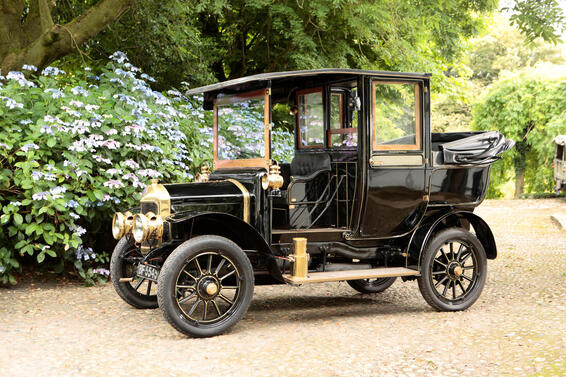
Georges Richard, having departed from Richard-Brasier, founded Unic. In 1905, he collaborated with the entrepreneur-financier Baron Henri de Rothschild, securing funding for the establishment of "société anonyme des automobiles Unic" based in Puteaux. The primary goal was to produce distinctive, non-mainstream vehicles. Initially, the company focused on crafting light cars and taxis equipped with two-cylinder and four-cylinder engines.
Unic's enduring connection with the taxi industry spanned over three decades, and Baron Henri de Rothschild's consistent financial backing provided crucial stability through both prosperous and challenging times. This steadfast support played a pivotal role in sustaining the business, especially during the tumultuous post-war years.
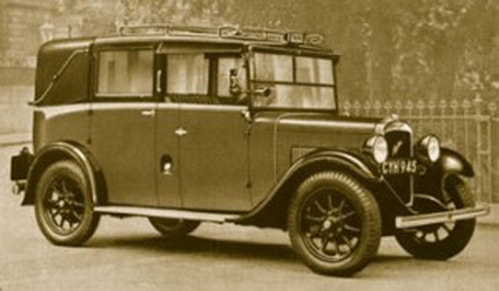 The first petrol Taxicabs in the UK were made by Austin.
The first petrol Taxicabs in the UK were made by Austin.
THE EFFECTS OF THE FIRST WORLD WAR IN JERSEY.
In 1916 registered Cab driver numbers fell significantly in Jersey, the Parish records show that there were only 12 names registered as plate holders, and some of these names registered held more than one plate, altogether there was a total of 31 plates registered compared to the 67 plates registered in 1915. The number of plates had more than halved, perhaps these men had signed up to join the other 6000 Jerseyman who had left the island to fight in the First World War.
The Parish of St Helier kept no more records from 1917 onwards until 1920, in that year 82 cab plates had registered. It was noticed that only 18 names out of the 67 from 1915 had registered for the same plate number in 1920.
Furthermore 12 of these names were registered plate holders in 1916 so we can presume that these men had not been sent to war, probably because of age or disability. Only six names reappeared again from the 1915 records... were they the only survivors?
THE NAME TAXICAB
In London the fitting of Taximeters was made compulsory as early as 1907 and cabs became known as 'Taxicabs,' today this is abbreviated to 'Taxi'. However, the term "Taxicab" in Jersey didn't come into use until a later period, emerging in the late 1920s. By 1930, 31 drivers presented a petition to the Constable of the Parish of St Helier, asserting their status as full-time Taxicab drivers. These drivers advocated for a change in regulations to prevent those who only operated during the summer months from utilizing the stands (Public Ranks).The petition highlighted the disparity between full-time and part-time drivers. Full-time Taxicab drivers were dedicated to providing consistent service year-round, even during the challenging winter months when earning a living proved difficult. In contrast, part-time drivers pursued other occupations during the winter months and only sought taxi stands during the busier summer period. The drivers argued that the Parish of St Helier's decision to permit an additional 30 part-time drivers to apply for stands during peak seasons was detrimental. They contended that these part-time drivers, lacking a year-round commitment to public service, primarily used the stands for personal convenience rather than serving the public interest. Consequently, they appealed to the Constable to restrict stand access to full-time drivers, ensuring a fair opportunity for consistent livelihoods throughout the entire year.
It was around 1932 that we start to see more motorised vehicles on the record books being registered as Taxicabs, the numbers grew every year as they became more reliable and a popular means of transporting people around the island.
In 1935 the Jersey States Motor Traffic office took over from the Parish authorities and were given total control of regulating and registering the Taxicab industry on the island.
The first registry book they kept in 1936 included the plate holders name and address, all the PSV plate numbers started with A1 up to plate A167 plus for the first time the registration number of all the vehicles were included, and then a separate list for PSV Badge holders.
That year they also introduced the new Taxicab regulations and 30 of the longest standing plate and badge holders were to be known as Public Rank Taxicabs and Broad Street Rank was given over to them exclusively.
In 1916 registered Cab driver numbers fell significantly in Jersey, the Parish records show that there were only 12 names registered as plate holders, and some of these names registered held more than one plate, altogether there was a total of 31 plates registered compared to the 67 plates registered in 1915. The number of plates had more than halved, perhaps these men had signed up to join the other 6000 Jerseyman who had left the island to fight in the First World War.
The Parish of St Helier kept no more records from 1917 onwards until 1920, in that year 82 cab plates had registered. It was noticed that only 18 names out of the 67 from 1915 had registered for the same plate number in 1920.
Furthermore 12 of these names were registered plate holders in 1916 so we can presume that these men had not been sent to war, probably because of age or disability. Only six names reappeared again from the 1915 records... were they the only survivors?
THE NAME TAXICAB
In London the fitting of Taximeters was made compulsory as early as 1907 and cabs became known as 'Taxicabs,' today this is abbreviated to 'Taxi'. However, the term "Taxicab" in Jersey didn't come into use until a later period, emerging in the late 1920s. By 1930, 31 drivers presented a petition to the Constable of the Parish of St Helier, asserting their status as full-time Taxicab drivers. These drivers advocated for a change in regulations to prevent those who only operated during the summer months from utilizing the stands (Public Ranks).The petition highlighted the disparity between full-time and part-time drivers. Full-time Taxicab drivers were dedicated to providing consistent service year-round, even during the challenging winter months when earning a living proved difficult. In contrast, part-time drivers pursued other occupations during the winter months and only sought taxi stands during the busier summer period. The drivers argued that the Parish of St Helier's decision to permit an additional 30 part-time drivers to apply for stands during peak seasons was detrimental. They contended that these part-time drivers, lacking a year-round commitment to public service, primarily used the stands for personal convenience rather than serving the public interest. Consequently, they appealed to the Constable to restrict stand access to full-time drivers, ensuring a fair opportunity for consistent livelihoods throughout the entire year.
It was around 1932 that we start to see more motorised vehicles on the record books being registered as Taxicabs, the numbers grew every year as they became more reliable and a popular means of transporting people around the island.
In 1935 the Jersey States Motor Traffic office took over from the Parish authorities and were given total control of regulating and registering the Taxicab industry on the island.
The first registry book they kept in 1936 included the plate holders name and address, all the PSV plate numbers started with A1 up to plate A167 plus for the first time the registration number of all the vehicles were included, and then a separate list for PSV Badge holders.
That year they also introduced the new Taxicab regulations and 30 of the longest standing plate and badge holders were to be known as Public Rank Taxicabs and Broad Street Rank was given over to them exclusively.
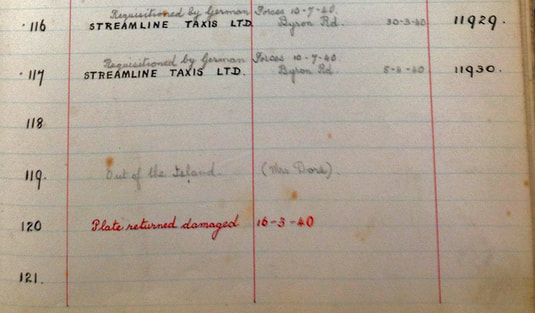 Streamline Taxis Ltd lost the most that year as they held 12 plates altogether and the records show that 5 of their vehicles had been requisitioned by German forces in 1940.
Streamline Taxis Ltd lost the most that year as they held 12 plates altogether and the records show that 5 of their vehicles had been requisitioned by German forces in 1940.
THE SECOND WORLD WAR.
The registry books for 1940 shows that the number of drivers again decreased significantly, English born drivers would have possibly evacuated the Island with the other 13,000 evacuees, many just abandoned their vehicles in a rush to leave the island before the occupation, as the records show that only 68 plate holders were registered out of a total of 177 plates in 1940, and only 80 registered badge holders,
You can see in the photo to the right the registry book kept in 1940 shows that some taxicab drivers and companies were starting to loose their vehicle as it was recorded German forces had commandeered 12 taxis that year and more were to follow.
Within days of the Germans occupation the local residents had to come to terms with new laws and orders such as no cars were allowed for private use, the German currency was introduced with an exchange rate of nine Reichsmarks to the pound, and new curfew laws, and of course there was fuel rationing.
By 1941 the number of Taxicab plate holders fell to only 12 registered, fuel was now in short supply or unavailable and buses were converted to run on gas, wood, charcoal and finally to be drawn by horses once again.
The Germans changed the rule of the road from driving on the left to the right, buses were forced to set down and pick up their passengers in the middle of the road. these conditions made it impossible for any Taxicab driver to make a living and most of the vehicles had now been commandeered by the Germans anyway.
In 1942 records show that there were only 6 registered plate holders and by 1943/44 no more plates were registered, just 7 PSV badge holders were recorded in 1943 and this fell to just 6 by 1944.
In 1945 we see that Taxicab drivers who had survived the 2nd World War were again registering with the Motor Traffic Office, that year 52 PSV plates and 47 PSV badge holders were registered, a decade later and the numbers had risen to a total of 227 plates registered, 84 of these were Public Rank Taxis and 133 Private Hire Taxicabs.
The registry books for 1940 shows that the number of drivers again decreased significantly, English born drivers would have possibly evacuated the Island with the other 13,000 evacuees, many just abandoned their vehicles in a rush to leave the island before the occupation, as the records show that only 68 plate holders were registered out of a total of 177 plates in 1940, and only 80 registered badge holders,
You can see in the photo to the right the registry book kept in 1940 shows that some taxicab drivers and companies were starting to loose their vehicle as it was recorded German forces had commandeered 12 taxis that year and more were to follow.
Within days of the Germans occupation the local residents had to come to terms with new laws and orders such as no cars were allowed for private use, the German currency was introduced with an exchange rate of nine Reichsmarks to the pound, and new curfew laws, and of course there was fuel rationing.
By 1941 the number of Taxicab plate holders fell to only 12 registered, fuel was now in short supply or unavailable and buses were converted to run on gas, wood, charcoal and finally to be drawn by horses once again.
The Germans changed the rule of the road from driving on the left to the right, buses were forced to set down and pick up their passengers in the middle of the road. these conditions made it impossible for any Taxicab driver to make a living and most of the vehicles had now been commandeered by the Germans anyway.
In 1942 records show that there were only 6 registered plate holders and by 1943/44 no more plates were registered, just 7 PSV badge holders were recorded in 1943 and this fell to just 6 by 1944.
In 1945 we see that Taxicab drivers who had survived the 2nd World War were again registering with the Motor Traffic Office, that year 52 PSV plates and 47 PSV badge holders were registered, a decade later and the numbers had risen to a total of 227 plates registered, 84 of these were Public Rank Taxis and 133 Private Hire Taxicabs.
1954 This was the year Jersey Taxi Drivers Association was founded.
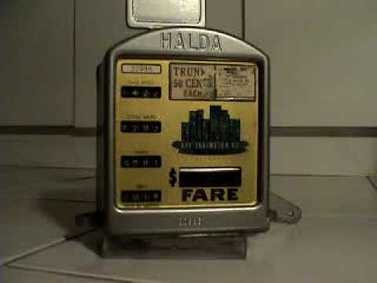
1955 a new regulation was passed that all Public Rank Taxis were to be fitted with a Taximeter approved by the Motor Traffic Office and each meter was to be sealed and no one unless authorised by an inspector of the Motor Traffic Office was allowed to remove or tamper with the seal, and this law still applies today.
Taxi fares were now controlled and set by the States of Jersey Defence Committee, but this rule did not apply to the Private Hire Cab Companies.
'Some Taxicab drivers had already fitted meters into their vehicles long before this regulation was passed'.
THE 'TAXIMETER'
In London the fitting of taximeters was made compulsory as early as 1907 and cabs became known as 'taxicabs' today this is abbreviated to 'Taxi',
Early Taximeters were totally mechanical in operation and the clock that recorded waiting time had to be wound by hand, Meters of the 1960s and 1970s had a built-in electric clock, but today Taximeters are fully electronic and calculate the fare payable as a combination of time and distance. When the Taxi is in motion, it records distance and when the Taxi is stationary it records the time spent standing still and adjusts the fare accordingly.
Taxi fares were now controlled and set by the States of Jersey Defence Committee, but this rule did not apply to the Private Hire Cab Companies.
'Some Taxicab drivers had already fitted meters into their vehicles long before this regulation was passed'.
THE 'TAXIMETER'
In London the fitting of taximeters was made compulsory as early as 1907 and cabs became known as 'taxicabs' today this is abbreviated to 'Taxi',
Early Taximeters were totally mechanical in operation and the clock that recorded waiting time had to be wound by hand, Meters of the 1960s and 1970s had a built-in electric clock, but today Taximeters are fully electronic and calculate the fare payable as a combination of time and distance. When the Taxi is in motion, it records distance and when the Taxi is stationary it records the time spent standing still and adjusts the fare accordingly.
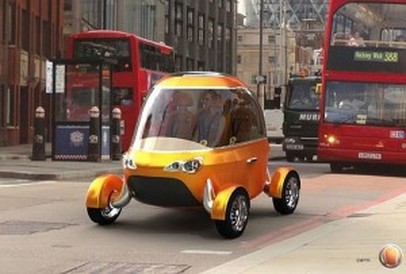 Testing the OPTI on London streets the driverless vehicles
of the future!
Testing the OPTI on London streets the driverless vehicles
of the future!
HOW PUBLIC RANK TAXIS AND PRIVATE HIRE CABS EVOLVED
During the 1950s with the rapid growth of home telephones, it became extremely easy to contract for-hire transportation and some Taxicab drivers quickly realised that their market was going to move towards trips ordered over the telephone.
Companies like Luxicabs formed and moved into depots, operators were set up to take telephone bookings and customer accounts, the jobs could now be despatched to vehicles fitted with new two-way in car radios systems, this was the start of the what is now known today as 'Private Hire Taxicabs'.
They were still regulated by the Motor Traffic Office, however they were allowed to set their own fares which were higher than Public Rank Taxis to cover the costs of providing a door to door service and the associated overheads of running expensive depots which included the need to have vehicles garaged and off the streets in-between jobs.
The owner drivers also had to pay weekly rents to the depot owners to cover the costs of these new overheads and their customers didn't seem to mind paying extra to get the door to door service.
During the 1960's there were 267 registered plate holders, 167 were Private Hire and 100 Public Rank Plates.
In 1965 new Taxicab regulations were brought in to update the outdated 1935 regulations, as things had changed with the two systems in operation.
Due to a disparity in pricing between Private Hire Cabs and Public Rank Taxis, the Motor Traffic Office introduced restrictions on Private Hire operators and drivers. They were prohibited from picking up passengers from Taxi Ranks or responding to street-hailed fares, and displaying Taxi roof signs was also forbidden. The intent was to eliminate confusion for customers. However, in the 1990s, the States of Jersey Defence Committee eased some of these regulations, leading to increased confusion between the two taxi systems in operation until 2018.In 2018, a significant legal change occurred with the implementation of a new one-tier taxi system. This integrated Private Hire Cabs and Public Rank Taxis into a unified system of Taxis for hire. All taxis were required to be affiliated with a booking entity, and they could seek hire through public ranks or street hails. This transformative shift marked the launch of the JERSEY TAXIAPP, providing a novel means of booking taxis through a dedicated app. Over time, it has evolved into the largest taxi operator on the island, boasting 96 registered drivers on the App as of 2023.
WHAT DOES THE FUTURE HAVE IN STORE FOR THE TAXICAB INDUSTRY?
We have seen many changes over the years within the taxicab industry and more so in recent years. The (DfI) Department for Infrastructure formally known as the (TTS) Jersey States Transport and Technical Services have taken the reins of regulating the Taxicab industry in Jersey, and the Motor Traffic office changed its name to the Driver and Vehicles Standards Department (DVS) which governs the industry.
There has also been considerable growth within modern communication technology with the development of smart phones and apps and satellite navigation. Many digital taxi booking applications using Cloud based servers and free to use Apps that can be downloaded onto smartphones, many of these applications also facilitate mapping of the taxi on route to the customer via GPS.
We have also seen many vehicle improvements with the drive for more Eco friendly cars and hybrids vehicles like the Toyota Prius, there was also the launch of the new Electric Taxi in London called the 'Metrocab' that can be run on zero emissions. However the cost of this vehicle has been a big issue amongst London taxi drivers and most are unwilling to fork out around £68,000 for a taxi, especially as the future of the industry is in doubt with the rise of more and more unregulated operators.
Could this be the end of the world famous iconic black London taxicab?
There has also been a notable surge in car-sharing companies and ride-hailing services globally, with Uber emerging as one of the largest, sparking considerable controversy, especially among licensed taxicab drivers. The primary source of contention arises from its lack of regulation in certain areas. Unlike London taxicab drivers who undergo rigorous testing, such as the renowned Knowledge test established in 1865, Uber drivers often face less stringent requirements.
Mastering the Knowledge test typically demands three to four years for students.
In Jersey, the emergence of the unregulated 'Jersey Lifts' Facebook page, functioning as a car-sharing platform, has drawn attention and plenty of controversy . Primarily utilised by individuals holding only a private driving license and possibly lacking proper insurance and even road worthy vehicles, this platform raises concerns as it facilitates an illegal taxicab service for hire and reward. Users are cautioned to acknowledge the associated risks and to beware of fake taxi/cab services. BEWARE FAKE TAXICABS
The future for traditional taxicab drivers appears uncertain, particularly with technology giants like Google and Uber testing new satellite-navigated driverless vehicles. Paul Piliste's vision of OPTI, an eco-friendly driverless taxi for London, is anticipated to hit the streets by 2025. However, skepticism lingers about trusting a driverless vehicle solely reliant on its SatNav to navigate safely through narrow country lanes for passengers and their families.
During the 1950s with the rapid growth of home telephones, it became extremely easy to contract for-hire transportation and some Taxicab drivers quickly realised that their market was going to move towards trips ordered over the telephone.
Companies like Luxicabs formed and moved into depots, operators were set up to take telephone bookings and customer accounts, the jobs could now be despatched to vehicles fitted with new two-way in car radios systems, this was the start of the what is now known today as 'Private Hire Taxicabs'.
They were still regulated by the Motor Traffic Office, however they were allowed to set their own fares which were higher than Public Rank Taxis to cover the costs of providing a door to door service and the associated overheads of running expensive depots which included the need to have vehicles garaged and off the streets in-between jobs.
The owner drivers also had to pay weekly rents to the depot owners to cover the costs of these new overheads and their customers didn't seem to mind paying extra to get the door to door service.
During the 1960's there were 267 registered plate holders, 167 were Private Hire and 100 Public Rank Plates.
In 1965 new Taxicab regulations were brought in to update the outdated 1935 regulations, as things had changed with the two systems in operation.
Due to a disparity in pricing between Private Hire Cabs and Public Rank Taxis, the Motor Traffic Office introduced restrictions on Private Hire operators and drivers. They were prohibited from picking up passengers from Taxi Ranks or responding to street-hailed fares, and displaying Taxi roof signs was also forbidden. The intent was to eliminate confusion for customers. However, in the 1990s, the States of Jersey Defence Committee eased some of these regulations, leading to increased confusion between the two taxi systems in operation until 2018.In 2018, a significant legal change occurred with the implementation of a new one-tier taxi system. This integrated Private Hire Cabs and Public Rank Taxis into a unified system of Taxis for hire. All taxis were required to be affiliated with a booking entity, and they could seek hire through public ranks or street hails. This transformative shift marked the launch of the JERSEY TAXIAPP, providing a novel means of booking taxis through a dedicated app. Over time, it has evolved into the largest taxi operator on the island, boasting 96 registered drivers on the App as of 2023.
WHAT DOES THE FUTURE HAVE IN STORE FOR THE TAXICAB INDUSTRY?
We have seen many changes over the years within the taxicab industry and more so in recent years. The (DfI) Department for Infrastructure formally known as the (TTS) Jersey States Transport and Technical Services have taken the reins of regulating the Taxicab industry in Jersey, and the Motor Traffic office changed its name to the Driver and Vehicles Standards Department (DVS) which governs the industry.
There has also been considerable growth within modern communication technology with the development of smart phones and apps and satellite navigation. Many digital taxi booking applications using Cloud based servers and free to use Apps that can be downloaded onto smartphones, many of these applications also facilitate mapping of the taxi on route to the customer via GPS.
We have also seen many vehicle improvements with the drive for more Eco friendly cars and hybrids vehicles like the Toyota Prius, there was also the launch of the new Electric Taxi in London called the 'Metrocab' that can be run on zero emissions. However the cost of this vehicle has been a big issue amongst London taxi drivers and most are unwilling to fork out around £68,000 for a taxi, especially as the future of the industry is in doubt with the rise of more and more unregulated operators.
Could this be the end of the world famous iconic black London taxicab?
There has also been a notable surge in car-sharing companies and ride-hailing services globally, with Uber emerging as one of the largest, sparking considerable controversy, especially among licensed taxicab drivers. The primary source of contention arises from its lack of regulation in certain areas. Unlike London taxicab drivers who undergo rigorous testing, such as the renowned Knowledge test established in 1865, Uber drivers often face less stringent requirements.
Mastering the Knowledge test typically demands three to four years for students.
In Jersey, the emergence of the unregulated 'Jersey Lifts' Facebook page, functioning as a car-sharing platform, has drawn attention and plenty of controversy . Primarily utilised by individuals holding only a private driving license and possibly lacking proper insurance and even road worthy vehicles, this platform raises concerns as it facilitates an illegal taxicab service for hire and reward. Users are cautioned to acknowledge the associated risks and to beware of fake taxi/cab services. BEWARE FAKE TAXICABS
The future for traditional taxicab drivers appears uncertain, particularly with technology giants like Google and Uber testing new satellite-navigated driverless vehicles. Paul Piliste's vision of OPTI, an eco-friendly driverless taxi for London, is anticipated to hit the streets by 2025. However, skepticism lingers about trusting a driverless vehicle solely reliant on its SatNav to navigate safely through narrow country lanes for passengers and their families.
TAXI TRIVIA
The difference between a ‘Taxi’ and a ‘Cab’ is that a Taxi has a Taximeter. It’s often claimed the Taximeter was invented by German Baron von Thurn und Taxis – descendant of the Italian Tasso (meaning ‘badger’) family. In fact, it was Wilhelm Bruhn and the word comes from French: ‘Taxi’ meaning ‘Tax’ and Metre.
There are a number of myths and legends that surround the London Cab and its cabmen and many of them are nothing but bunkum. For instance, it has never been law for a motor cabman to carry a bale of hay in his cab. In fact, it was never law for a horse cabman to carry one, although he was required to carry sufficient hard food (e. g. oats) for his horse’s midday feed.
Nor has there ever been a law that says that London’s Taxis should be black. A Taxicab may be any colour, but when the Oxford and the FX3 were introduced, their makers supplied them in a standard colour of black. Few buyers were prepared to pay the extra money for a special colour and so for three decades, black became the norm. In the late 1970s, Carbodies offered a wide range of pleasing colours for the FX4 to the ever-growing number of owner-drivers and now Taxicabs are found in a very wide range of colours, including special advertising liveries.
The difference between a ‘Taxi’ and a ‘Cab’ is that a Taxi has a Taximeter. It’s often claimed the Taximeter was invented by German Baron von Thurn und Taxis – descendant of the Italian Tasso (meaning ‘badger’) family. In fact, it was Wilhelm Bruhn and the word comes from French: ‘Taxi’ meaning ‘Tax’ and Metre.
There are a number of myths and legends that surround the London Cab and its cabmen and many of them are nothing but bunkum. For instance, it has never been law for a motor cabman to carry a bale of hay in his cab. In fact, it was never law for a horse cabman to carry one, although he was required to carry sufficient hard food (e. g. oats) for his horse’s midday feed.
Nor has there ever been a law that says that London’s Taxis should be black. A Taxicab may be any colour, but when the Oxford and the FX3 were introduced, their makers supplied them in a standard colour of black. Few buyers were prepared to pay the extra money for a special colour and so for three decades, black became the norm. In the late 1970s, Carbodies offered a wide range of pleasing colours for the FX4 to the ever-growing number of owner-drivers and now Taxicabs are found in a very wide range of colours, including special advertising liveries.
